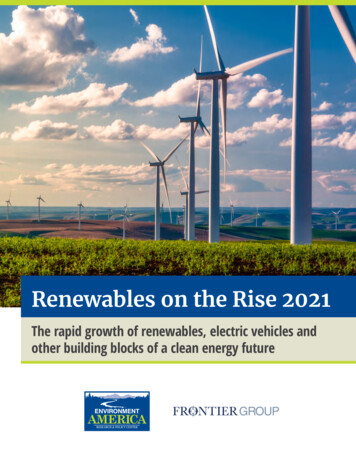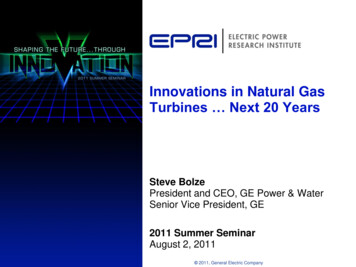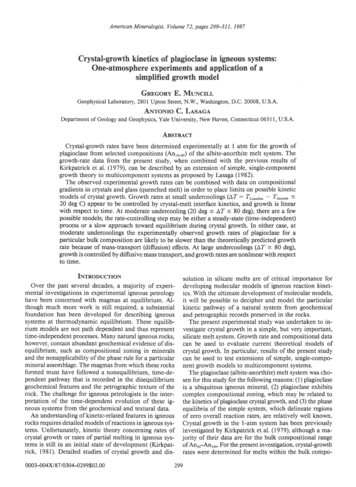
Transcription
Renewables on the Rise 2021The rapid growth of renewables, electric vehicles andother building blocks of a clean energy future
Renewables on the Rise 2021The rapid growth of renewables, electric vehiclesand other building blocks of a clean energy futureWritten by:Sarah Nick and Tony Dutzik, Frontier GroupEmma Searson, Environment America Research & Policy CenterNovember 2021
AcknowledgmentsEnvironment America Research & Policy Center sincerely thanks Chris Harto, Senior Transportation PolicyAnalyst at Consumer Reports; Bill Holland, Senior Director of State Policy and Advocacy for the League of Conservation Voters; Steve Nadel, Executive Director of the American Council for an Energy-Efficient Economy; andJohn Rogers, Senior Energy Analyst at the Union of Concerned Scientists for their review of drafts of this document, as well as their insights and suggestions. Thanks also to Jamie Friedman, formerly of Frontier Group, for hersignificant contributions to this analysis, and to Susan Rakov, Bryn Huxley-Reicher, Adrian Pforzheimer and JamesHorrox of Frontier Group for their contributions and editorial support. Environment America Research & PolicyCenter thanks all those who provided funding to make this project possible.The authors bear responsibility for any factual errors. The recommendations are those of Environment AmericaResearch & Policy Center. The views expressed in this report are those of the authors and do not necessarilyreflect the views of our funders or those who provided review. 2021 Environment America Research & Policy CenterEnvironment America Research & Policy Center is a 501(c)(3) organization. We are dedicated to protecting our air,water and open spaces. We investigate problems, craft solutions, educate the public and decision-makers, and helpthe public make their voices heard in local, state and national debates over the quality of our environment and ourlives. For more information about Environment America Research & Policy Center or for additional copies of thisreport, please visit www.environmentamericacenter.org.Frontier Group provides information and ideas to build a healthier, more sustainable America. We focus on problems that arise from our nation’s material and technological wealth – the problems of abundance. We deliver timelyresearch and analysis that is accessible to the public, applying insights gleaned from diverse fields of knowledge toarrive at new paths forward. For more information about Frontier Group, please visit www.frontiergroup.org.Layout: Alec Meltzer/meltzerdesign.netCover photo: Wind farm in eastern Washington state, Gareth Janzen, via Shutterstock.com
Table of contentsExecutive summary. . . . . . . . . . . . . . . . . . . . . . . . . . . . . . . . . . . . . . . . . . . . . . . . . . . . . . . . . . . . . . . . . 1Introduction. . . . . . . . . . . . . . . . . . . . . . . . . . . . . . . . . . . . . . . . . . . . . . . . . . . . . . . . . . . . . . . . . . . . . . 4Clean energy technologies are booming across America . . . . . . . . . . . . . . . . . . . . . . . . . . . . . . . . . . . . . 5Solar energy has grown 23-fold since 2011 . . . . . . . . . . . . . . . . . . . . . . . . . . . . . . . . . . . . . . . . . . . . . . . . . . . . . . . . . . . . . . . . . 5Wind energy has nearly tripled since 2011. . . . . . . . . . . . . . . . . . . . . . . . . . . . . . . . . . . . . . . . . . . . . . . . . . . . . . . . . . . . . . . . . . 8America continues to become more energy efficient. . . . . . . . . . . . . . . . . . . . . . . . . . . . . . . . . . . . . . . . . . . . . . . . . . . . . . . . . . 11More than 2 million plug-in electric vehicles have been sold . . . . . . . . . . . . . . . . . . . . . . . . . . . . . . . . . . . . . . . . . . . . . . . . . . 16Battery energy storage has grown 18-fold since 2011 . . . . . . . . . . . . . . . . . . . . . . . . . . . . . . . . . . . . . . . . . . . . . . . . . . . . . . . . 18The U.S. can and must accelerate clean energy progress . . . . . . . . . . . . . . . . . . . . . . . . . . . . . . . . . . . . 22Accelerating the pace of change . . . . . . . . . . . . . . . . . . . . . . . . . . . . . . . . . . . . . . . . . . . . . . . . . . . . . . . . . . . . . . . . . . . . . . . . . 22Technology is improving . . . . . . . . . . . . . . . . . . . . . . . . . . . . . . . . . . . . . . . . . . . . . . . . . . . . . . . . . . . . . . . . . . . . . . . . . . . . . . . 22Prices are falling. . . . . . . . . . . . . . . . . . . . . . . . . . . . . . . . . . . . . . . . . . . . . . . . . . . . . . . . . . . . . . . . . . . . . . . . . . . . . . . . . . . . . . 24Conclusion and recommendations. . . . . . . . . . . . . . . . . . . . . . . . . . . . . . . . . . . . . . . . . . . . . . . . . . . . . 25Appendix: Detailed state data. . . . . . . . . . . . . . . . . . . . . . . . . . . . . . . . . . . . . . . . . . . . . . . . . . . . . . . . 27Notes . . . . . . . . . . . . . . . . . . . . . . . . . . . . . . . . . . . . . . . . . . . . . . . . . . . . . . . . . . . . . . . . . . . . . . . . . . 35
Executive summaryClean energy is sweeping across America and ispoised for more dramatic growth in the comingyears.Wind turbines and solar panels made up a tiny fractionof our energy infrastructure 10 years ago. Today, theyare everyday parts of America’s energy landscape. Thenumber of homes heated with clean, efficient electricheat pumps increased by 28% in a decade from 2005 to2015.1 Just a few years ago, electric vehicles seemed a faroff solution to decarbonize our transportation system.Now, they have broken through to the mass market.Virtually every day, there are new developments thatincrease our ability to produce renewable energy, apply itto a wider range of energy needs, and reduce our overallenergy use. These developments enable us to envision aneconomy powered entirely by clean, renewable energy.In 2020, America produced almost four times as muchrenewable electricity from the sun and the wind asin 2011, with wind and solar producing 11% of ournation’s electricity in 2020, up from 3% in 2011.2Between 2011 and 2020, U.S. wind, solar and geothermal generation grew at an annual rate of 15%.3 If thoseforms of renewable generation were to continue to growby 15% per year, wind, solar and geothermal wouldproduce enough electricity to meet all of our currentelectricity needs by 2035.4The last decade has proven that clean energy can powerAmerican homes, businesses and industry, and has putAmerica on the cusp of a dramatic shift away from polluting energy sources. With renewable energy prices fall-1Renewables on the Rise 2021ing and new energy-saving technologies being developedevery day, businesses, cities, states, and the nationshould work to obtain 100% of our energy from clean,renewable sources.The last decade has seen explosive growth in the keytechnologies needed to power America with clean,renewable energy. Solar energy: America produces over 23 times as muchsolar power as it did in 2011, enough to power morethan 12 million average American homes.6 In 2011,solar rooftops and utility-scale solar power plants produced 0.14% of U.S. electricity; in 2020, they produced2.3% of America’s electricity. In 2019, the 2 millionthsolar PV system was installed, and an additional million installations quickly followed by summer 2021.7 Wind energy: America has nearly tripled the amountof wind power it produces since 2011, enough topower over 31 million homes.8 In 2011, wind turbinesproduced 3% of the nation’s electricity; in 2020, theyproduced 8.4% of America’s electricity.9 Energy efficiency: Electric efficiency programsacross the U.S. saved over 17% more energy in 2019than in 2011, as states ramped up their investmentsin efficiency. In 2019, these programs saved enoughelectricity to power more than 2.5 million homes.10 Electric vehicles: In 2011, just over 16,000 battery andplug-in hybrid electric vehicles were sold in the U.S.As of December 2020, cumulative sales had grown100-fold to nearly 1.7 million vehicles.11 By mid-2021,plug-in electric vehicle sales had surpassed 2 million.12
140,000120,000100,00080,00060,00040,00020,0000Wind energyWind electricity generation (GWh)Solar electricity generation (GWh)Solar ,00002011 2012 2013 2014 2015 2016 2017 2018 2019 00,000600,000400,000200,0000Battery storage3,200Annual salesCumulative sales2,800Energy capacity (MW)SalesElectric vehicles2011 2012 2013 2014 2015 2016 2017 2018 2019 20202,4002,0001,6001,2008004002011 2012 2013 2014 2015 2016 2017 2018 2019 202002011 2012 2013 2014 2015 2016 2017 2018 2019 2020 2021(through July)Figure ES-1. Growth in clean energy technologies5 Battery storage: In 2020, the U.S. had over 1.7 GWof battery storage capacity. America’s battery storagecapacity grew more than 18-fold from 2011 to 2020and grew by 67% in 2020 alone.13The recent growth in renewable energy across America is due in part to strong and supportive publicpolicies. To accelerate the transition to clean energy,cities, states and the federal government should: Heat pumps: The efficiency of heat pumps hasimproved to the point where they are now anattractive and realistic option for homes across thecountry. In 2015, 12% of all U.S. homes with heatused heat pumps, up from just 8% a decade earlier.14Shipments of efficient air-source heat pumps fromU.S. manufacturers nearly doubled between 2011and 2020, increasing by 10% in 2020 alone.15 Set ambitious targets for renewable energy, followingthe example of the nine states and nearly 200 citiesand towns that have committed to getting 100% oftheir electricity from clean or renewable sources ofenergy within the next several decades.16 In addition,governments should set specific targets for deployment of key clean energy technologies, such as solarpower, offshore wind energy and energy storage.Executive summary2
Establish strong incentives for renewable energyadoption, including extension of federal tax creditsthat have helped to fuel the growth of renewableenergy over the last decade and local and state cleanenergy incentives. Policy-makers should expand andimprove existing clean energy incentives to makethem easier to use and to ensure that they deliverbenefits to everyone wanting to participate in thedrive toward a clean energy future. Ensure that utility policies fully and fairly compensate investors in clean energy technology for thebenefits they bring to the environment, society andthe electric system through mechanisms such as netmetering for rooftop solar systems, and adopt policiesfor permitting and interconnection that make adoption of clean energy technologies easy and hassle-free. Encourage the transition to electric vehicles andelectric buildings through strong clean cars stan-3Renewables on the Rise 2021dards, local commitments to transition to electrictransit and school buses, and policies to supportfuel-switching in residential and commercial buildings from gas and oil to electricity. Support the integration of technologies and practices that will enable America to take full advantage of its renewable energy potential, includingthe integration of energy storage into the grid, thedevelopment of resilient local microgrids poweredby renewable energy, and the appropriate expansionof transmission infrastructure to allow for the transport of renewable energy from the places where it isabundant to the places where it is needed. Encourage continued steady progress on energyefficiency by continuing and expanding local, state,utility and federal programs and policies, includingutility energy efficiency programs, building energycodes, and appliance efficiency standards.
IntroductionImagine a world powered by clean, renewableenergy.A world without the threat of oil spills in our oceanwaters, without the specter of precious Arctic wildernessbeing destroyed forever to provide the world with a fewmonths of oil, without leak-prone oil pipelines traversing natural lands and critical waterways, and withoutthe air pollution from vehicle tailpipes that puts thehealth and lives of millions of Americans at risk.A world in which mountaintops aren’t removed toaccess the coal beneath, abandoned coal mines don’tleak acid into our waterways, coal ash ponds at powerplants don’t pose an imminent threat of destructionto the wildlife in our rivers and streams, and the flowof soot into our skies from power plant smokestacksdisappears.A world in which our homes are no longer dependentfor heat upon leaky gas delivery systems, the combustion of gas for cooking doesn’t jeopardize our health,and fracking does not put the health of our communities and the water they drink at risk.And a world in which the United States taps our abundant clean energy resources to lead the globe in eliminating the carbon pollution that threatens the future ofour children and grandchildren.That world is not here yet. Far from it. But the outlinesof it can be seen in the extraordinary progress the UnitedStates has made in the last decade in renewable energy.Solar panels and wind turbines, electric vehicles andelectric heat pumps, energy storage systems and LEDlight bulbs – all of them were uncommon, even exotic,technologies in recent memory, but are becomingincreasingly common features of everyday life. Whilefossil fuels still dominate America’s energy system, it isnow possible for more and more Americans to envisiona future in which most of the daily tasks of life can bepowered with clean, renewable energy.The growth of renewable energy in the United States isinspiring, but it is no accident. It is built on the foundation of decades of research and strong public policiesthat have helped to bring exciting clean energy technologies out of the lab and into our communities.This report describes the dramatic growth of renewableenergy and clean energy technologies across America– a shift that has touched every corner of America. Yetthere remains much work to be done to convert thepromise of renewable energy into the cleaner, healthierand more sustainable future we now know is possible.It is time for America to redouble its commitment to aclean energy future – and adopt the public policies thatcan make it a reality.Introduction4
Clean energy technologies arebooming across AmericaIn the last 10 years, the U.S. has made rapid progress toward repowering our economy with clean,renewable energy.Ten years ago, key clean energy technologies were limited to niche markets and only just beginning to gainmomentum. Today, the rapid adoption of wind and solarpower and energy efficiency technologies – along with theemergence of electric vehicles and energy storage – provides a glimpse of what is possible in the transition to aneconomy powered entirely with clean, renewable energy.Solar energy has grown 23-fold since 2011Energy from the sun is emission-free and virtuallyunlimited: enough sunlight hits the earth every hour tosupply the world’s energy needs for an entire year.17Despite its abundance, tapping into solar energy forelectricity was difficult and prohibitively expensive formost people until the early part of the 21st century. By2011, years of intensive research, along with pioneeringpro-solar policies adopted by states such as Californiaand New Jersey, had begun to pave the way for increasedadoption of solar energy. In 2011, solar energy accountedfor 0.14% of America’s electricity, or enough to powernearly 530,000 of today’s average American homes.18The pace of solar adoption in the U.S. has been accelerating. In 2016, the U.S. saw its millionth solar panelinstallation; the 2 millionth installation came justthree years later, in 2019.19 In 2021, the U.S. passed thebenchmark of 3 million solar panel installations.205Renewables on the Rise 2021What is clean, renewable energy?Not all renewable energy sources have equalbenefits for the environment. Some forms ofbiomass and hydroelectric power, for example,can create serious environmental problems.Truly clean, renewable energy is: Virtually pollution-free, producing little to no global warming pollution orhealth-threatening pollution; Inexhaustible, coming from natural sourcesthat are regenerative or practically unlimited. No matter how much we use, there willalways be more; Safe, with minimal impacts on the environment, community safety and public health,and those impacts that do occur are temporary, not permanent; and, Efficient, representing a wise use of resources.Although all energy sources must be deployedresponsibly, solar and wind energy generally meetthese criteria, as do many types of ocean, tidal,river current and geothermal energy. Energy efficiency technologies also count as “clean energy”– delivering continuous environmental benefit atlimited to no environmental cost.
In 2020, solar power generated 2.3% of America’selectricity, over 23 times as much as in 2011, and a 24%increase from 2019.21 Solar power provided enoughelectricity to power over 12.4 million homes, or moreelectricity than was produced by power plants in all ofNew England that year.22Solar energy is growing both in small-scale residentialinstallations and in utility-scale plants. Small-scale solargrew over 10-fold from 2011 to 2020, and utility-scalesolar grew 50-fold in the same period.23 America is projected to add 15.4 GW of new utility-scale solar powerby the end of 2021, accounting for 39% of the nation’snew electricity generating capacity. That is an increaseof 28% compared with the nearly 12 GW of new utility-scale capacity installed in 2020.24California has the largest market for solar power in thecountry, and has been a long-time model of renewableenergy adoption.25 California’s installed solar capacityprovides almost a quarter of the state’s electricity, enoughto power over 4.5 million typical American homes.26The Million Solar Roofs Initiative, adopted in 2006 andlargely completed a decade later, was a major drivingforce for accelerating solar growth in the first half of thedecade, growing California’s solar capacity more than12-fold.27 California has also adopted policies to ensurethat homeowners and businesses investing in solar powerare fully compensated for the benefits they deliver to theenvironment, society and the grid. Among those policiesis “net metering,” which has played an important role insupporting the growth of solar power in the territories ofthe state’s three major investor-owned utilities.28 California has also committed to further growth in solar byadopting a requirement stating that all new homes builtin California must have solar.29Texas is expected to experience a solar boom in upcoming years. In 2020, Texas installed 2.5 GW of solarcapacity, and is expected to install another 10 GW by2023.30 The growth in utility-scale solar power in stateslike Texas, as well as Arizona, Nevada and other sunnystates, is driven in part by the rapidly declining cost ofsolar power, as well as policies both incentivizing andrequiring solar production.31Many of the states with the most rapid solar energygrowth – including Massachusetts and New Jersey –have also benefited from a suite of strong solar policies.Solar carve-outs in renewable electricity standards setsolar energy adoption requirements, and policies suchas net metering ensure that solar PV system owners areappropriately compensated for the energy they supply tothe grid.32TABLE 1: TOP STATES FOR SOLAR ELECTRICITY GROWTH, 2011 TO 202034StateSolar electricity net generation (GWh)Growth from 2011-2020 (GWh)Rank by 22North 057Massachusetts823,9053,8238New Jersey6444,1173,4739New York973,4223,32510CaliforniaClean energy technologies are booming across America6
Solar electricity generation e 1: Solar electricity generation grew more than 23-fold from 2011 to 20203350,000Solar electricity generation 5,00010,0005,0000CATXNCFigure 2: Solar energy production, top states, 2011-2020357Renewables on the Rise 2021AZFLNVGAMA
Figure 3: America’s top states for growth in solar energy production since 201136Wind energy has nearly tripled since 2011Like sunlight, wind is abundant and emission-free, andwind energy has experienced dramatic growth over thelast decade.Wind power is not a new concept. People have usedwindmills to do work for more than 1,000 years, and thefirst electricity-generating wind turbine was built in thelate 19th century. By 2011, wind energy generation wasgaining momentum, producing 3% of America’s energythat year, enough to power over 11 million homes.37The last decade has seen dramatic growth in wind energy.From 2011 to 2020, American wind generation nearly tripled.38 In 2020, wind produced 8.4% of America’s electricity, enough to power over 31.6 million homes.39The past decade also saw the construction of America’sfirst offshore wind farm, the 30 MW Block Island WindFarm off the coast of Rhode Island, which began operation in 2016.40 More recently, in 2021, Vineyard Windreceived approval to build an 800 MW wind farm offthe coast of Massachusetts.41 The project will include 62GE Haliade-X turbines, among the largest-capacity off-shore turbines worldwide.42 A number of other offshoreprojects are planned for later years.43The United States has the technical potential toproduce more than 7,200 terawatt-hours (TWh) ofelectricity from offshore wind, which is almost twotimes the amount of electricity the U.S. consumed in2019 and about 90% of the amount of electricity thenation would consume in 2050 if we transitioned ourbuildings, transportation system and industry to runon electricity instead of fossil fuels.44 The Departmentof Energy has set a goal of 30 GW of offshore windpower in operation by 2030, significantly more than thecurrent 42 MW capacity.45 With an ambitious goal inplace, upcoming projects in the pipeline, and growth inthe domestic supply chain, the U.S. is poised to soonbecome a major producer of offshore wind turbines andof power from offshore wind.46Midwest and Southwest states have led the nation ingrowth of wind energy. From 2011 to 2020, Texas,Oklahoma and Iowa were the leading states in additionsof wind power. Wind generation more than tripled inTexas and Iowa, and quintupled in Oklahoma.47Clean energy technologies are booming across America8
Texas dominates wind energy generation in the U.S.,producing a quarter of the nation’s wind energy, theequivalent of nearly 21% of all electricity sold in Texasin 2019.48 Texas’ wind energy growth was initiallytriggered by the renewable electricity standard it established in 1999, and more recent growth was enhancedby a 7 billion investment in the state grid, completedin 2013, which allowed for the transmission of windenergy from the state’s windiest regions to its biggestcities.49 Texas also benefits from tax exemptions anddeductions for wind energy-generating properties andbusinesses.50TABLE 2: STATES WITH MOST ADDITIONAL WIND GENERATION, 2011 VS. 2020 (GWH)52StateNet wind electricity generation (GWh)Growth from 2011-2020 (GWh)Rank by nois6,21317,11110,8985North rnia7,75213,6455,89310TexasOklahomaIowa400,000Wind electricity generation 000020112012201320142015Figure 4: U.S. wind energy production nearly tripled from 2011 to 2020519Renewables on the Rise 202120162017201820192020
100,000Wind electricity generation 0,00020,00010,0000TXOKIAKSILNDNECOMICAStateFigure 5: Wind energy production, top states for wind energy growth, 2011-202053Figure 6: America’s top states for wind energy growth since 201154Clean energy technologies are booming across America10
Three states now produce wind and solar power equivalent to 50% ofthe electricity they consumeWith falling energy use and expanding wind andsolar generation, renewable energy now accountsfor a significant percentage of U.S. electricity use.In 2020, wind and solar power produced 11% of allU.S. electricity generation.55 In 2020, 16 states gen-erated wind and solar energy equivalent to at least20% of the electricity they consumed.56 Three states– Iowa, North Dakota and Kansas – generated windand solar power equivalent to at least half of theirelectricity needs.TABLE 3: TOP 10 STATES BY WIND AND SOLAR GENERATION AS PERCENTAGE OFELECTRICITY CONSUMPTION57StateWind and solargeneration (GWh)Retail electricitysales (GWh)Rank, bypercentageIowa34,38449,80569.0%1North lahoma29,66961,79048.0%4South Dakota5,60812,49844.9%5New 56,37526.5%10ColoradoAmerica continues to become moreenergy efficientThe task of moving to 100% clean, renewable energycan be made dramatically cheaper and easier by reducing the amount of energy wasted in inefficient buildings, cars and equipment.Between 1950 and 2007, total energy use in the UnitedStates nearly tripled. Since then, however, energy use in11Wind and solar generationas % of electricity salesRenewables on the Rise 2021the United States has stayed roughly the same, despite agrowing population and economy. On a per capita basis,energy consumption in the U.S. fell nearly 2% from2011 to 2019.58 America experienced a sharper declinein energy use – of 7% – between 2019 and 2020 as thenation experienced widespread shutdowns and disruptions due to the COVID-19 pandemic.59 In 2020, primary energy consumption in the U.S. was 282 millionBtu per capita – the lowest consumption since 1965.60
Will 2020 spark new energy-saving trends?In 2020, the world was struck by the COVID-19pandemic, leading to business shutdowns, stay-athome orders, and a severe economic slump. Energyconsumption declined dramatically. Some energysavings improvements over the past year are likelytemporary. But some of the changes brought aboutby the pandemic may continue, influencing energyconsumption – in either a positive or negative direction – for years to come. Commercial energy efficiency: A secondaryeffect of work-from-home is the reduction indemand for office space in urban downtownsand suburban office parks alike. The efficiencywith which those spaces are used – or theability to convert them to other uses – may havelong-term effects on energy consumption andthe effectiveness of energy efficiency and cleanenergy policies targeting those buildings. Commuting: 2020 saw an immediate anddrastic decrease in travel, especially travel towork. The number of vehicle-miles traveledfell by 13% from 2019 to 2020, while transitridership fell by 65% in the second half of 2020compared to pre-pandemic levels.61 Many workplaces shifted to remote work: an October 2020Pew Research Center poll found that, amongworkers whose jobs could mainly be donefrom home, 71% were working fully remotely,compared to one in five before the pandemic.62Many companies are planning to continue withsome form of remote work even after the end ofthe pandemic.63 The impact of remote work onoverall energy consumption is unclear – whilemost studies suggest that it reduces energy use,some studies suggest that it may have littleeffect or even increase energy consumption.64Maximizing energy savings from telecommutingmay require new approaches, such as improvingresidential energy efficiency and enabling morenon-commute car trips to be replaced by transit, biking and walking. Retail and delivery: The pandemic alsoaccelerated the growth of online retailers likeAmazon and the demise of traditional “brickand mortar” retail. The energy consumptionimpacts of delivery services like Amazon are –like the impact of telecommuting – uncertain,and dependent on the degree to which deliveryreplaces trips to the store that would otherwisebe taken in cars, the efficiency of the deliveryprocess itself, and other factors.65 Efforts to electrify and improve the efficiency of the deliveryprocess, minimize the environmental footprintof distribution centers and other infrastructureof the online economy, and repurpose existingretail space in sustainable ways are likely tobecome more important in the years to come.The COVID-19 pandemic changed how Americans live their lives in ways that will continue tohave ripple effects long after the pandemic is over.Policy-makers must pay attention to those trends,and do their best to ensure that the progress madetoward clean energy and energy efficiency continuesafter the pandemic ends.Clean energy technologies are booming across America12
Energy consumption per capit
2015.1 Just a few years ago, electric vehicles seemed a far- . electric buildings through strong clean cars stan-dards, local commitments to transition to electric transit and school buses, and policies to support . Consumer Reports---,”










